How I Feed My Dog Without Plastic
You may remember that my Plastic Free July pledge this year was to stop buying dog food in plastic, and start making it myself. Aside from the plastic, I didn’t love that the brand that suited our greyhound best was imported from the USA, I didn’t love that it was supporting industrial agriculture, and I didn’t love that it was highly processed.
These are all things I try to avoid, and I was very conscious that buying this was against so many things I believe in.
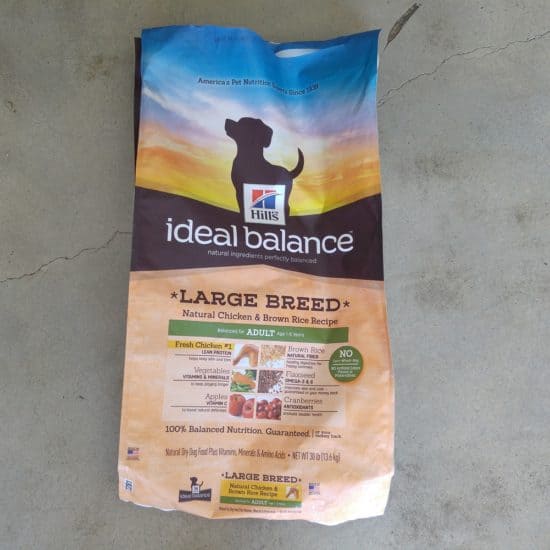
Believe me, we tried other brands. We tried all of the Australian ones, and several other high quality ones. Whilst he ate them all with equal vigour (our boy loves his food), we noticed other effects: fat depositing around his neck, weight gain, loose stools, and one brand that led him to go to the bathroom four times every single day.
Not to mention, all the brands left his skin very itchy. Sometimes he would nibble at his legs so much his skin would bleed.
Enough is enough. I had to at least try homemade dog food.
Our greyhound Hans came to live with us a year ago. It was time to stop making excuses, and start knuckling down and getting the plastic-free dog food happening.
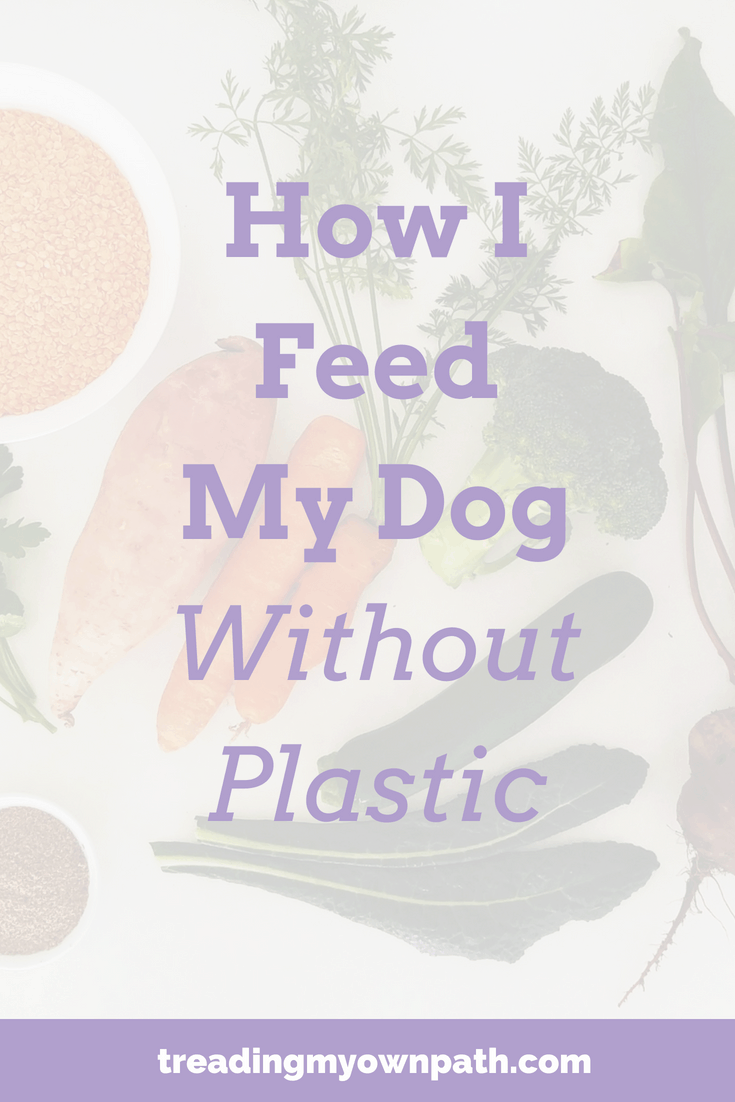
 Getting Started with DIY Dog Food
The internet can be an overwhelming place, and full of contradictory information as to what is best. My three main concerns were:
- How would I know how much to feed him? (Wet food is very different to dry food.)
- How would I ensure he was getting all the nutrients he needed?
- How would I know that the food was safe?
Before I go any further, disclaimer. I am not a vet, nor am I an animal dietitian. This is not professional advice nor a recommendation. This is what I am exploring for our dog based on my own research and am sharing for information purposes only. Please do you own research or consult a professional.
How Much Do I Feed My Dog?
There are plenty of guidelines for feeding dogs wet or homemade food on the internet – and of course, they are all slightly different! I realised that if I underfed or overfed him, it would eventually become apparent with changes in his weight, energy levels and appearance.
Hans weighs 30kg, and he’s being fed 800g – 1kg of food per day.That seems to fit within most recommendations.
How Do I Ensure My Dog Gets All the Nutrients They Need?
I worried about this for a while, before realising that there are plenty of commercial pet foods that fall short here. Dog nutrition wasn’t even considered a few decades ago. Not forgetting, there are plenty of people who do not consume all the nutrients that they need.
In natural habitats, dogs are scavengers. They don’t get two meals a day fed to them out of a bowl. They might not get two meals a day.
That’s not to say I don’t want to do my best. But it gave me some perspective.
I looked into nutritional supplements to add to homemade dog food, but many of the recommended ones are not available in Australia.
I looked at the labels to discover the ingredients, did some research into the nutritional benefits, and opted to make my own.
How Do I Know My Homemade Dog Food Is Safe?
That was the easiest one to answer, because there is plenty of information on the internet regarding ingredients that are safe for dogs, and those that are not.
The second thing I found helpful was to look at the ingredient lists on the dog food I was buying, and try to mirror these ingredients in the dog food I was making.
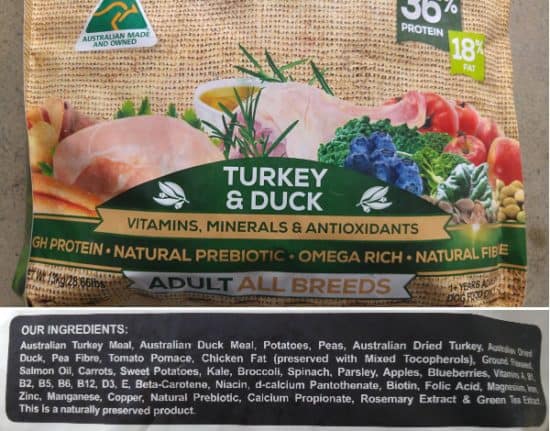
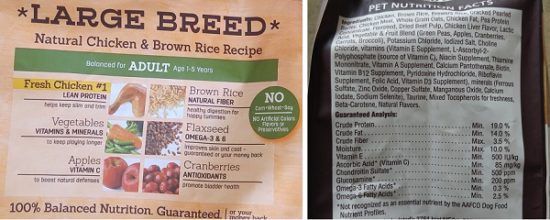
Half the ingredients are things commonly available: carrots, sweet potato, rice. Other ingredients had unpronounceable names. For these, I asked the internet:
- What is [insert name of unpronounceable ingredient]?
- What foods contain [unpronounceable ingredient]?
Then, if I wasn’t sure, I’d ask: is [food containing unpronounceable ingredient] safe for dogs?
It turned out that these ingredients were either preservatives or a component/vitamin/mineral found in many natural foods.
In terms of toxicity, or malnutrition – these things become apparent over time. We are keeping a close eye on Hans and if we notice any change in his appearance or behaviour, we will consult a vet.
DIY Homemade Dog Food – Vegetable Component
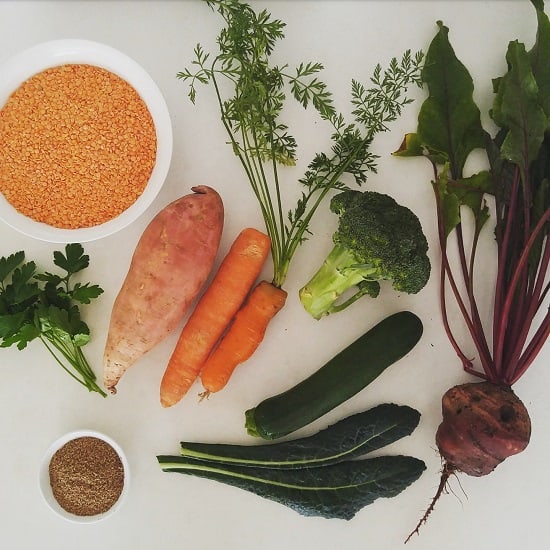
Dogs need protein, fat, minerals and vitamins. Dogs don’t actually need carbohydrates at all. Carbohydrates like white rice and corn are typically used in commercial dog foods as a filler, because they are cheap. But they offer little nutritional value.
For several months before I embraced the DIY dog food, I tested various ingredients on our greyhound. I’d add a small amount to his bowl along with his kibble. He gobbled everything up. And I mean everything.
I’ve heard that greyhounds can be fussy eaters. Not our boy!
The vegetable component has three parts, in equal proportions.
1. Protein component: 33%
Rather than use carbohydrates as a base, I use lentils. They are cheap but contain protein and vitamins. Typically I use red lentils as they are quick to cook. I soak for 30 mins, rinse thoroughly, and boil in a pan for 30 minutes. Once they have cooled I blend to a puree.
Red lentils are my preferred choice, but I have also used green/brown lentils, puy/French lentils, chickpeas and black beans. (Chickpeas and black beans require much longer soaking and cooking times.)
2. Sweet Potato or Pumpkin Cooked Vegetable Component: 33%
Sweet potato is a good vegetable to give dogs, because it contains beta-carotene, a pre-cursor to vitamin A. It also grows well in Western Australia and is available all year round.
Occasionally I use pumpkin (butternut squash or Japanese pumpkins) as an alternative.
I grate in my food processor, then steam for 12 minutes until cooked, and blend together with the lentils.
3. Raw Vegetable Component: 33%
This tends to be mix of whatever is in the fridge or the garden, but typically is 50% raw carrots and 50% of a mix of green leafy vegetables, beetroot, brassicas (broccoli, cauliflower), zucchini/courgette and cucumber.
These are blended together raw, and then mixed with the lentils and orange vegetable components.
DIY Dog Food – Vegetable Fats
I add a tablespoon of oil (olive oil or coconut oil) to every meal, and/or 1 tablespoon of ground flax seeds. Hans is also a huge fan of both peanut butter and tahini so I sometimes stir this through his food as a treat.
DIY Dog Food – Animal Products Component
Hans gets a fair amount of protein from the vegetable component of his diet, but we also add fish, eggs and other animal products.
Sardines: 4-5 per Week
Rather than feed Hans fish oil or supplements, it makes sense to me to feed him whole sardines. He eats whole sardines (head, guts and all) and he loves them.
Eggs: 2-3 per Week
Several of our friends have egg-laying chickens, so we source our eggs directly from them rather than buying commercially produced eggs. I also save the eggshells, wash, dry and grind them into a powder, and add a tablespoon along with a raw egg mixed in with his food.
Chicken Necks: 4 a Day
We’ve got a system with our butcher now where we drop off a big container, and when he gets chicken necks in, he fills up the container and gives us a call to collect. I was terrified of giving Hans chicken necks at first because I’d read that dogs can swallow them whole. Of course, the first time I gave him one, he swallowed it whole. And the second one. Naughty boy!
Now I have to hold them at either end and feed them by hand to ensure he bites in the middle and chews before swallowing.
Other Meat
I’m still finding my way with this one. I’m still exploring the various butchers and trying various options, and I don’t have an answer… yet. Hans is happy with whatever he gets, so it’s up to me to find a waste-free, sustainable and local option that I’m happy with.
DIY Dog Food – Nutritional Supplement
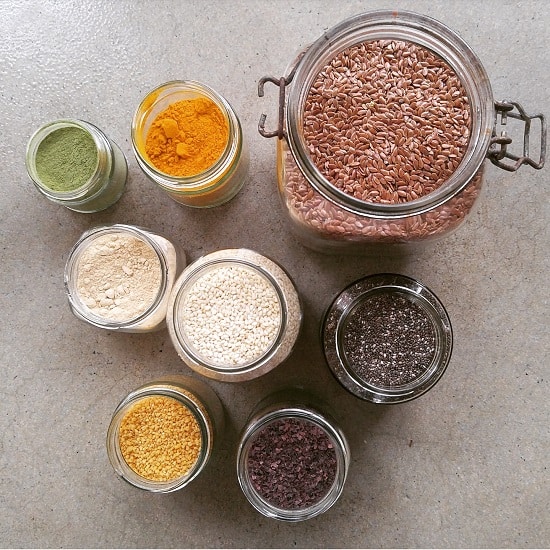
I make up a supplement to add to the dog food to give it an extra nutritional punch. I looked at a number of supplements (both available for purchase and DIY recipes), looked up the nutritional content of each ingredient, and made my own based on that, along with what ingredients I could find.
The ingredients I use: ground flax seeds, ground sesame seeds, chia seeds, barley grass powder, lecithin, turmeric, maca powder, and seaweed (either dulse flakes or wakame).
(I realise these ingredients might sound very foreign! I’ve been able to find most of them in bulk at The Source Bulk Foods, who have 35 stores across Australia. The only one they don’t stock is wakame. They also sell other things like brewer’s yeast and other green powders which can be used instead/as well as. Outside of Australia, I’d try a health food shop.)
I’m still playing around with quantities of each ingredient, and also how much to use.
DIY Dog Food – Progress so Far
So far, we have been DIYing it for about 7 weeks. As with all new habits, getting into a routine is the hardest part. We’ve also had to pretty much empty our freezer of our food to fit in Hans’ food!
I can’t report back regarding cost yet, as we are still finding our way. I hope to do an updated post in a few months with actual recipes and costs involved.
The Positives:
Hans loves his new food! He gets much more excited now we’re serving up fresh food than he did with kibble (although he still thought kibble was pretty darn fantastic.)
I feel better about what I’m feeding him. I just feel more comfortable knowing his food is natural and not made in a factory somewhere overseas.
His energy levels are unchanged.
His stools are much better! Which is very helpful when you’re trying to pick them up with newspaper and take home to compost ;)
He has completely stopped itching. Whatever it was that was irritating his skin in the kibble, it’s no more. Hurrah!
The Negatives:
Hans has lost a bit of weight. Actually, we think he might have been a little overweight before (something that is VERY hard to tell with a greyhound). Lots of people have commented on how good he looks and how good his coat looks. But we are keeping an eye on him to ensure he doesn’t get too skinny.
We now have a new friend (or should I say trip hazard) in the kitchen. Whereas he never showed much interest before, now he knows that his dinner comes from there, he is like a constant companion. And if you open the fridge door – there he is beside you!
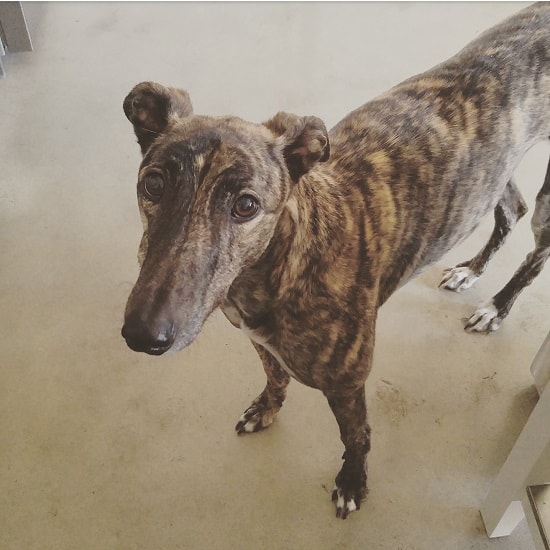
Did I just hear the pantry door open?
Now I’d love to hear from you! This is all new to me, so I’d love to hear from your experiences. Do you make your own dog food, and if so, what ingredients do use use? What lessons have you learned? If you want to give it a go but are unsure where to start, what are you stuck on? Are you a vet and do you have any (off-the-record) advice? Anything else to add? Please leave a comment below!
[leadpages_leadbox leadbox_id=1429a0746639c5] [/leadpages_leadbox]







We’ve been feeding raw and making our own dog food since 2006. Highly recommend Clare Middle’s book Real food for dogs and cats.
We also use Claire’s book. Explains things well.
Thanks Nina – it is now on order from the library :)
Thanks for the suggestion Deb :) I’ve just requested it from the library.
I love that Hans is now actively more interested in his food now! Goes to show that enjoying fresh homemade meals isn’t just a human prerogative
Hi Stephanie, oh believe me he has always been interested, but now it is tenfold! He is also picking up on new sounds. Mostly the sound of various containers being opened. Can you believe he can actually hear a banana being peeled from the other room? We are not sure how either. He’s a real foodie!
Hi Lindsey, we own a greyhound as well. And I also try, so far very unsuccessfully though, to minimize our waste. We feed our 1 year old greyhound Prins kibble. We live in the Netherlands and it’s produced in the Netherlands so that was a pro. However its packaging is plastic and I would very much love to avoid that. I give him raw meat two days a week and the rest of the week his kibble. I give him pens, tripes in French not sure what the English word is, but it is the stomach of a cow. It is called ‘waste’ here because people in the Netherlands don’t generally eat it. It’s very cheap and extremely healthy for dogs because in nature they would eat the intestines first as well. Apart from that it contains all vegetables and stuff the animal was eating and partially digested as well which brings me to my question. Dogs are said to not have the enzymes to digest vegetables and such which is why they eat the intestines of the animals they would naturally prey to get the vitamins and such they need without having stomach trouble. So that would be my only concern. I find it very difficult to find a ethically comfortable stand in this. I would like to have only meat from animals that are treated okay and not support any practices that are even slightly malicious. So still looking and researching here.
By the way, our greyhound poops a lot too which worries me a bit too, as it may be a sign he is not properly digesting his food. But other than that he looks very good and is happy and healthy.
Hi Gitane – oooh, you have a greyhound too! Tripe is the English word :) I want to be able to find those kind of “waste” meats and they are fairly common in the UK, but here the butchers only sell fancy stuff. I’m not even sure the butcher where I get chicken necks from even sells liver. I keep meaning to check. I bought chicken mince but I feel bad buying human grade meat that means more chickens are getting killed – I would rather buy the bits that people don’t want.
When I say I grate the veggies, actually I blend them to a puree (I just thought “grate” was easier for those without a good blender that can deal with solid veggies). As you say, they aren’t great at digesting veggies, so if they are blended it helps the nutrients absorb. The blending does some of the work of the enzymes. I still think fresh veggies are better than any processed kibble “veggies”.
Hans pretty much goes twice a day, sometimes once. When he was on one brand of food, he was going four times and we are talking serious amounts. His stools have always been loose, particularly when he goes more than once, but since we switched to this they are much better. It is probably slightly more than the kibble, but I guess it’s the extra fibre.
I’ll have to ask the butcher about tripe and all those things. As I said, I’m still figuring that part out. I noticed another butcher said they had rabbit, but not sure if it is wild or farmed, or how it is packaged. The journey continues…
P.S the ‘pens’ contains the vegetables but already partially digested by the enzymes in the stomach of the cow that’s why it is better to digest for dogs. Not sure if I said that in my post above.
And concerning the kibble we give Django, the Prince dogfood we have is pressed and not baked like many others which makes it much better to digest. It is very pure as far as my knowledge tells me. But still it is processed and will never be the same as fresh food.
I will see if i can find tripe. There is a NZ brand of dog food that is super premium and made from dehydrated or baked or some better kind of processing, but it is still processed and super expensive. I figured for that I could probably feed Hans steak every day! Not that I would – I’m pretty sure greyhounds aren’t eating cows in the wild.
What a beautiful boy! I was looking forward to this post since you said you were going to make his food. Thanks for this. I’d love to make homemade food and this post makes it feel less overwhelming!
Thanks Cari. As I get a little more informed I hope to post another update – probably in a few months from now. I found it so overwhelming at first – I had so many tabs saved and links etc. In the end I realised that the kibble wasn’t the most fantastic thing ever, so I just needed to start and adjust and keep researching. Being responsible for another life is such a…well, a responsibility!
I have been making our dog, a boarder collie, Max’s own food for 8 months now. He was having some aggression issues, biting people, growling. I had him at specialist vets etc. They drugged him again and again. In my heart of hearts I knew it was all wrong but the option of putting down our sweet dog, who had only become aggressive recently, was too much to think about. The vet recommended giving him flax seed oil for anxiety but by then he was so sick from the drugs that he was refusing to take tablets. One day I googled an anxiety diet for humans and decided to make his food. Every where recommended brown rice, leafy greens and flax seed (called linseed). I had cooked food for him before but he didn’t like it so I based my mix on raw. Now he has pre cooked brown rice, beef mince, raw spinach leaves, raw grated carrot and ground flax seed.I freeze it in containers. OMG he is a completely different dog!!! Sweet again, happy and according to our regular vet the healthiest she has ever seen him. Recently I ran out of raw food so fed him some dry food for one meal and i am not joking he not only growled at me but at his bowl. I think he was trying to tell me something :)) A month ago I watched a documentary on Netflix called Petfooled. Its all about the pet food industry and its a complete eye opener. I highly recommend it.
Hi Kerry, thank you so much for sharing your story. And I’m so glad your dog is now happy. I love border collies – I can’t imagine them growling at anyone. I love the thought of your dog growling at their kibble ;)
Flax seed seems to be in a lot of commercial dog foods, and we add it to his food most days. I use the seeds as I can grind myself rather than buy the oil, and keep the jar in the fridge. Sounds so delicious! We have mixed mince in a few times, but now we prefer to keep them separate. If I freeze anything it’s veggies only – I don’t want to ever make the mistake that it’s pasta sauce and feed myself raw chicken mince!
Someone on social media recommended Petfooled too. I think it is one I want to see! But I don’t have Netflix. I’m going to ask around and invite myself over to someone’s !
Thank you for this great post and for the interesting comments, especially the behavior comments. It sounds like a lot of work? I switched from tinned food to dried to reduce the waste but would love to feed our dog resh food. How often have you been making up the mix? Look forward to hearing your progress. Thanks for all your positive suggestions. Am aiming for a change a week. All the best Sam
Hi Sam, and thanks for the comment – great question! Honestly, at first it felt like a HUGE amount of work. But I knew if I bought kibble “just in case” I’d make excuses and fall back to that. And habits take time to adopt.
Our biggest issue is that we are the owners of a tiny freezer, which is mostly full of human food. We’ve slowly been using up things in there to make more space. It would be much easier to batch cook/prepare if we had space to store. Currently I am cooking 2-3 times a week. It’s not that much more effort aside from the dishes, and it is definitely beginning to feel much less of a chore than it was at the start. We keep the veg separate from any meat so it can sit in the fridge for 5 days – I wouldn’t do that if it had raw meat.
Once I’m in more of a routine I’ll know exactly how much I need to cook per week, and we can get the shopping in sync (we currently always seem to be out of one thing).
A work in progress!
This is awesome as we have a rescue greyhound and are in Australia too. I buy dog mince zero waste from the butcher and I have been buying Australian kibble in bulk from a small business but I am now feeling more confident to have a crack at making stuff this weekend!
Hi Miffy, that’s so great – all the greyhound owners amongst us! We tested out all the things separately so we knew it wouldn’t go to waste – various veg, tahini, peanut butter, lentils – before mixing all together.
Let me know how you get on :)
Hello Lindsay,
Thank you so much for sharing this regarding feeding Hans natural food. I had always fed my dogs natural food and then was told by a vet that if I would only use the Kibble my troubles would be over. It’s just commercial blah and I’m reverting to a natural diet for them. You’re right about Kibble making dogs itchy.. I am going wholesale over to a natural diet from now on. How we get hoodwinked. Wendy
Hi Wendy, my pleasure! Everyone I know or have spoken to about this and have switched from kibble to a natural diet have made the comment about how it reduces itching. Poor Hans would be like crazed dog sometimes trying to itch, so it is so much better knowing that he isn’t so uncomfortable. It’s definitely a bit daunting to DIY – especially when there’s so many opinions on the internet! – but we will track how it goes and of course, if we see anything amiss we will be straight to the vet. Good luck with it and if you want to run any ideas by me, get in touch :)
Thanks. I’m going to try this for my two rescue dogs too. I also ordered Clare middles book from the library.
I’m looking forward to getting my hands on a copy! I’ve read a lot already, but not an actual book so hopefully it will go a bit deeper. I love to know the “why” as well as the “how” :) Let me know what you think once you’ve read it! :)
Thanks for sharing this. Great read. I have been thinking about switching my dogs and cat to raw food for some time now. My greyhound can be hyper, destructive, and anxious, and I truly believe it is his way of telling us that kibble and tin food is not working for him. Not to mention I hate all the waste and the supporting intensive industrial farming! I am going to try to get Clare Middle’s book from the library :) Thanks for sharing this. I am also doing a dog nutrition course, but for those who are short on time, check out the following videos. They are only a few minutes long but are easy to follow if you are new to the concept or wanting to reiterate your own other findings: http://get.dogsnaturallymagazine.com/2017-funnel/raw-feeding-basics-course/?inf_contact_key=5fcc5e860eb08395b6b8b17535f434b1d8bc0dbeda26074f93c6aa32c859620b
Hi Davina, thanks for sharing :) I like the titles – they all sound very interesting! Looking forward to having a look. Currently watching the one about rabbit poo dog food ;) The lady is very passionate!!!
Hi Lindsay, thanks for sharing your experience! Wouldn’t it make sense to upgrade to a larger freezer? Freezers are so handy to avoid (human) food waste, and it seems it would help in adopting the dog food habit if you only have to cook for him once a week. Compromises?! ;-) cheers
Haha, possibly Claire! We spent ages finding the most energy efficient fridge freezer, and it has quite a small freezer – so now I feel reluctant to buy another freezer! ;) Honestly I should actually clear ours out of the stuff that’s been in there rather too long, and see how much space we have. Maybe in the long term, but I want to see if we can make it work first. Fingers crossed!
omg i was just talking on fb about this yesterday!
Great post Lindsay, love your thorough research! Pat Coleby has a good book on pet nutrition too. We buy “pet mince” in bulk from our butcher or the local abattoir, its very cheap, some plastic involved, but you could probably organise your butcher that does the chicken necks to help you with offal of some kind. We add to the mince whatever veges we have in excess, I grate up broccoli stalks, carrots, apples, chokos etc, try to give them a bit of variety and plenty of fibre. We have chickens, so any time there are eggs to spare the dogs get 2-3 per day. Pat Coleby suggested supplementing with dolomite and seaweed, so they get a scoop of that too. you can get more bulk supplements from a farm produce store, they often have garlic, seaweed, dolomite etc in bulk bins, particularly in areas with horses. I think I’ll start adding more of the supplements that you’ve suggested here. We also feed some grain-free dry dog food occasionally as a back up if we run out of the meat, so I think that tops up any vitamins/minerals that the dogs miss out on. Overall they are way healthier on this diet than processed food containing grain fillers (as you mention, it is just cheap, no benefit to the dogs). Our last dog was overweight and ended up with diabetes after a life of processed dog food, so I was determined to make a change for our current two pups.
Thanks for sharing, Liz! Yes, our butcher has pet mince, and we drop our containers off and he fills them up and gives them back. It’s very cheap. Initially I wanted to avoid it as it has lamb, which greyhounds don’t agree with often, but in the end it seems the most practical solution. Our butcher is very accommodating. I think he gets a lot of pet owners dropping off their containers – hopefully not too many that he gets sick of it! But otherwise he puts it all into black styrofoam trays, which aren’t an option for us.
I’m sad your last dog got diabetes :( May your current pups live long and healthy lives.
Hi! I have also recently started making my own B.A.R.F (biologically appropriate raw food) for our dog Marley and cat Slinx. It is a work in progress on many levels!
I started my research by looking into ingredients of commercial brands of B.A.R.F and ratios of fruit & veg to animal based proteins, then looked up specific foods to see if they were safe to feed (I found that you shouldn’t feed any ‘nightshade’ family; potato, capsicum, eggplant, tomato or cruciferous veg or onions or that some dogs don’t digest carrots).
For now, I have gone with the 50% raw meat/organs/offal, 25% raw meaty bones, 25% blended raw fruit and veg plus a few extras like blitzed linseed, turmeric ‘golden paste’, egg & whole fish.
We are lucky that we can go shooting on-farm and responsibly/humanely source rabbit & kangaroo locally, plus take advantage of the scraps when our family kill lamb or beef for us… it’s an icky job but It’s good to know where and how you got your meat.
I also go to our local butcher for chicken frames and have even asked about them making up a specific dog meat blend with the proper ratios of meat/ fat/ organs/ offal, they have been pretty receptive but its early days. I have been taking my re- used 2ltr & 4ltr ice-cream containers into the butcher but it’s hit & miss with the timing; I sometimes get there too late and they have already minced the chicken frames and frozen it in 1kg plastic bags :(
My biggest issue is how to portion & freeze this amount of food so I only have to defrost just enough, as most of these ingredients come in large quantities or at random intervals. Ideally I’d have all the raw fruit, veg & other supplements ready just when we get a few roos to mince so I could mix it together, portion it & freeze it up….but that has never worked… yet!
On the plus side, my cat seems happy to eat whatever my dog gets and my dog is looking great and does not have any stinky dog smell, she smells really good!
I’m looking forward to seeing your updates & recipes!
Hi Ashleigh! The book I was recommended above and have now got from the library is all about the BARF diet. It was an interesting read, and some of the ideas were great, but others won’t work for us. For example, the writer talks about how fasting is good for dogs and 5 meals per week is good. Hans currently has 14 (2 a day), he loves his food and I don’t want to take that from him!
The other issue we have is that whilst he loves bones, they make him sick. Chicken necks are fine, but proper bones, no good.
I’m having similar trials about how to portion and freeze just enough. I’m slowly clearing our freezer out of human food so there’s more room for Hans, but I never seem to have enough containers. Still, it get easier all the time. I use a 5kg bucket (repurposed from the bulk store) for chicken necks and some donated yoghurt tubs and ice cream containers from friends. I have to drop the containers off and then pick up a few days later, and I don’t want to leave my Pyrex there.
I swear Hans is eating better than us these days!
Hi Lindsay
This is a well timed post and has given me the motivation to do it for my two little rescues. So far they are loving it. Easier than I thought too.
Thanks Judith! Glad your dogs are enjoying their homecooked food. One downside I’ve noticed – Hans is now incredibly interested in what is going on in the kitchen, and is a constant trip hazard!
Hi there!
I feed my dogs (30kg and 35 kg) since puppyhood with fresh meat. it is great to see, that more and more people stop feeding industrial doogfood, because it’s not only not sustainable, but also more expensive and makes your pet sick. so I think it’s great to give more pet owners inspirations through this blog post.
I would recommend you however to increase the amount of meat and give less veggies and less supplements. If your dog gets different meat parts aswell as liver, kidney, etc, he doesn’t need so many supplements anymore, because everything the dog needs is in the meat. don’t forget the bones!
of course, it is some kind of “religion” how to perfectly feed our best friends, so there are some who feed veggies and this who don’t feed any. I don’t feed vegetables, unless I have left over food and instead of throwing it away, I’m feeding it to my dogs. In my opinion, the healthiest way how to feed a dog, is to have a look how our grand parents generation fed them — and how they fed themselves! all the industrial and plastic food that affects us, also affects our pets. so it’s always good to have a look how dogs got fed the past 10.000 years and obviously survived until today.
however, I recommend every dog owner (or cat owner!) to have a look at these two forms: BARF and prey model raw. I personally feed more “prey” than “BARF”, but I don’t take it as my religion. Don’t forget the dog is a carnivore and it is always better to feed meat and bones in bigger pieces (every dog will get used to it) and if your have ingredients or supplements that deliver the same thing (e.g. fat or protein), it is always better to give them the non vegetable one (e.g. fish oil instead of vegetable oil).
I go to the butcher every 2 weeks and he fills up my buckets with meat left overs, which can’t be sold for humans and would be thrown away. it is the best dog food ever!
all the best for you and your dogs/cats!
and the best thing about feeding mostly/only meat: no need to cook or prepare anything. I only pack the meat pieces in 1,5kg and freeze it, so I unfreeze one pack a day. makes very little work and no trash at all, as I buy the meat in a bucket and I pack it in boxes to freeze it.
Hi Cecile, thanks for sharing your thoughts! We are still figuring out how much meat (and what meat) versus vegetables to feed him. I read the book suggested by Deb and Nina above in the comments, and it is about the BARF diet. The writer is a vet, who started the BARF diet many years ago. She says dogs are scavengers and omnivores, and recommends 25% veggies I think. That makes sense to me – if Hans was in the wild he could catch a rabbit or a chicken, but I wouldn’t fancy his chances with a lamb! He’s be eating all the fruit and vegetables! Whilst we will always feed him vegetables for practical reasons, our hound loves them! Apparently some greyhounds are fussy eaters, but not our boy.
Since writing this I’ve been getting pet mince from the butcher, we have a container deposit system going on, which is great. It’s the decanting into our freezer that I find tricky – due to space and containers. But we will get there.
We bought Hans lamb bones, and he has thrown up after all but one of them. (No more than 1 a week). He also throws up if he has more than a tiny amount of offal. Greyhounds have pretty rubbish diets on the track, so if he was fed pasta and corn flakes (I’m not sure what he ate, but honestly, some of the food greyhound trainers feed their dogs is crazy – it’s all on the forums) for 3.5 years, and then kibble for the next year, he hasn’t had the best start! But he likes chicken necks, and sardines, and eggs, and… well, everything, really! He was always quite partial to kibble, but he loves this food so much more!
So excited to see this post! Thnks for all the ideas! You sound so much more careful with Hans’s diet than we were with our Sophie’s. She was on raw meats and scoffing veggies within a week of adoption. We just made sure to google anything new to make sure it wasn’t poisonous. But we still go through a LOT of plastic with her meals. Meat, bones and offal are hard to find. I’ve only had byo container success at family-owned Asian butchers. I highly recommend Asian butchers for offal and treats like fresh pigs ears or trotters. They sell just about any kind of organ, which is great for adding variety (and essential for nutrients). I’ve read the absolute best thing nutritionally is green (unbleached) tripe but I’m yet to find anywhere in Perth that sells it, sadly.
I love your chicken neck arrangement! Try freezing a few together into one solid chunk and feeding them till frozen to Hans. That should slow him down! Also, don’t be scared to just give the entire egg to him. Sophie now has an elaborate technique of gently piercing an egg with her canines, licking the egg white that leaks out, then cracking the egg open in half to lick the yolk out, then munching the shell. Sometimes she won’t eat the shell, not sure why… but it’s not sharp enough to do any harm.
Tip for plastic-free dental care for greyhounds. Plaque off is a dry algae supplement that helps slow the build up of plaque. It comes in small plastic canisters shipped from the US. But you can buy a little lab sample plastic jar of it (or a smiliar brand) from Kalmpets in Balcatta (maybe other vets?) and they will take the empty container back to refill. They might be willing to fill your own glass jar.
Oh, regarding cost… I recommend buying fresh sardines whenever you can. They cost about $6-7 per kilo and will be zero waste if you byo container. Tinned sardines cost closer to $40 per kilo, and you have an addition to the recycling bin. But in saying that, the only place I knew of that sold sardines closed down, boo. (and was replaced by my favourite RSPCA op shop – yay!)
Hi Anna, thanks for sharing your thoughts! We’ve got a great butcher here in Vic Park, very accommodating with the containers. I drop them off, then pick them up later in the week when full. Your suggestion about Asian butchers is a good idea, thanks for that. Are there any you recommend? My Vic Park butcher was talking about green tripe the other day, a customer requested it. He said because it is unwashed, he is not allowed to sell it at his butchers and that would be the same for all butchers. So you’d need to find it at a pet food only place.
I don’t give Hans whole eggs because I don’t want him to know what eggs are ;) and also if the egg shell isn’t very fine, he won’t eat it. So I save the shells, wash and grind to a powder. I’ve been doing this for years to add to the garden/soil, so now I just feed Hans a spoonful.
I’m intrigued by this “Plaque Off” stuff. I will have to do some research!
Haha, I can’t believe you thought I’d buy tinned sardines. The waste! ;) It’s really hard to find them without salt or tomato sauce anyways, and you’re right, super expensive as well as super wasteful. We buy sardines from Fremantle. We buy a couple of kilos at once as we aren’t down there very often.
Hi Lindsay, I’m in the process of adopting a greyhound (yay!) Whereabouts in Freo do you get sardines unpackaged? Thanks! Love your posts
Hi Jenna! I go to Sealanes. They bag them up in the freezer but if you ask they sometimes have the boxes unbagged behind the counter. You have to time it with when they get a delivery! They also have pilchards, you can do the same with these. Alternatively you can buy the fillets that they sell marinated as unmarinated frozen fillets (again, you have to ask) but they work out much more expensive, as you are paying for the fillet and the marinade even though you’re not getting that bit. They are super helpful, just have a chat with them :)
I’ve had an interesting time trying to get bones not wrapped in plastic. Some butchers will agree to wrap bones in butchers’ paper only (‘do you want a carry bag? ) but others have told me it ‘hasn’t been around for 20 years’. One got all bent out of shape about me using my own container. Sigh.
The butchers near me have all been great, thankfully! At least you’ve found some that are willing to assist you!
Just found your blog and wanted to comment. I make my own dog food, developed a recipe on the Balance IT website, which was developed by a veterinary nitrtionist. They recommend corn oil as most other oils are lacking the ALAs needed by our canine companions.
Thanks for sharing Jennifer! :) Will have a look!
My dogs have eaten home cooked food for years. I cook up chicken drumsticks, remove them and then add red lentils or brown rice to the stock, throw in pumpkin and sweet potatoes until they’re cooked. I shred up whatever greens I’ve got spare in my garden. I remove the chicken from the bones and add that to the mix. I then cook the bones down in water for 24 hours to make a stock, the bones are soft enough to mash up so I add that mash into the mix. I will add in some flaxseed oil and voila! She gets a handful of roo meat or an egg every day on top of her meal. Her breath is sweet, her coat doesn’t smell and she doesn’t get fleas. Yay.
Thanks for sharing Katie! It feels so much better to be cooking good food for our pets, I think :)
It’s taken me a while to read this post but I wanted to add a book I found a few years ago now : “Nibble Munch Chomp: The art and science of feeding your pet” Dr Sasha Herbert who is (or was) the Senior vet at the Lort Smith Animal Hospital here in Melbourne. There are recipes for all kinds of pets, but most recipes are suitable for dogs (it lists that in the book).
Sadly we don’t have a dog yet, we do have 2 cats. For the cat owners I write: I have tried a couple of recipes from the book that sounded great for humans, but they were not interested in anything cooked. Cats are really hard to feed without waste and they are not fans of too much vegies so mostly meat and fish. One of our cats eats a lot of different stuff and I can feed her waste-free offal from the butcher or I buy the 1kg packs of Kangaroo meat (human grade because the pet stuff has an awful smell and blue-green streaks from the preservative). I portion this up into 35g serves and freeze in pairs so I just defrost a couple of dinners at a time. It takes around a month to go through 1kg and that’s only 1 plastic bag (haven’t found kangaroo mince at any butchers).
The other cat however, won’t eat much and even goes off his food if a tin has been open more than 2 days. He grazes and the other cat eats anything left behind. I have tried cooked and raw fish & chicken. He won’t eat any red meat. He likes crackers and pastry so we have to stop him stealing our food. But I have found that he will eat stuff sprinkled with nutritional yeast flakes! I have heard this is ok for cats in small amounts (best check with your vet first).
At the moment we buy kibble in big bags (reducing our plastic but not yet without), which has no preservatives and is made in Australia. The tin food is a supplement, also made in Australia and no preservatives or additives – just chicken or fish, sometimes with cheese (?) or seaweed. But I want to get away from the tins, so if anyone has any ideas I’d love to hear them.
Thanks for sharing Sarah! I’ve heard that cats are much more difficult to feed, partly because they are carnivores, not omnivores, and partly because naturally they would eat rodents and small birds, not beef or lamb etc! Plus they seem to be fussy eaters, unlike most dogs… Appreciate you sharing your experiences :)
Hi, I respectfully suggest that anyone interested in feeding a dog a healthy diet which is not kibble based, and there are those who will argue that the words ‘kibble’ and ‘healthy’ cannot be in the one sentence, look at some of the Youtube videos of Dr Judy Morgan? You will begin to realise that there are no good kibble foods, just expensive, not so expensive and cheap. I’d also suggest that one reconsiders feeding veg to your dog? A dog’s systems struggles to break down veg which provides no benefits? Whilst most veg, things like onions etc being the obvious exceptions, won’t cause any direct harm the fact that the animal’s system is using up energy in an effort to process the veg means that the dog is being unnecessarily burdened. Some veg like sweet potato and carrot are starchy which can lead to skin issues. Finally, the recommended ratio for feeding dogs is 80/10/10%. 80% of the diet, which by the way is ideally between 2-3% of the dog’s weight, should be meat; 10% should be offal of which 5% is better being liver and 10% needs to be bone. All of these components are necessary for a dog’s good health with each playing a vital part and are not negotiable. Bones can serve two related but separate roles, providing calcium etc when consumed and cleaning the teeth when chewed on. Following this diet supplements are not usually necessary but there is no doubt that oils like flax or fish will help the coat and skin. Some argue that to prevent food allergies protein should be changed from time to time. The challenge for those of us with vegetarian and or vegan leanings is to understand that we cannot impose our beliefs on the dog. The dog needs meat. The other challenge can be to find a meat source that sits with our ethical and moral beliefs but speaking for myself I have had to thread lightly there because my dog’s health and well being is the priority. However I draw the line at non stunned Halal and to be safe don’t feed any Halal killed meat.
This is by far the best article I’ve seen for zero waste dog food! So often the scientific component, ratios, and supplements are left out which makes me hesitant to try them! Thank you for this, you’re a life saver!
Thanks Angel! I’ve read a lot of papers ingredients on dog food and books out of the library, and I’ve come to something that I’m happy with. I’m clearly not a vet but I did have the opportunity to speak to my vet about the food since writing this and she was very pleased with everything. I also get pet mince (human grade) from the butcher and chicken necks (ditto) because I decided that it was best and they are considered “waste” products.
I was wondering if you could please give a rough idea of cost?
I usually cook my dog foods, I keep searching on internet what is good and what is bad, that why I read article that this one. Thank a lot for sharing.
Girls, Emi Kamiya, Devon Schuster, Carly and Melanie. Brette Polin when she see these girls she can’t stand them she hates them just by looking at them and wants to fight. Becarefule of Brette Polin she is crazy!
I think I’m gonna start cooking healthy food for my dogs too. I had the misconception of home made food will make your dogs sick and stomach issues. Now I know home made healthy food it’s ok and better.
Thank you so much for sharing your knowledge.
Thanks for this Lindsay! It’s on my PFJ list this year. Very helpful!!